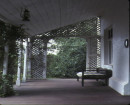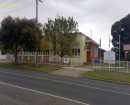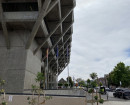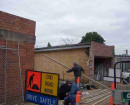D'estaville
7 Barry Street KEW, Boroondara City
Barry Street Precinct, Kew
-
Add to tour
You must log in to do that.
-
Share
-
Shortlist place
You must log in to do that.
- Download report


Statement of Significance
HO143 Barry Street Precinct, Kew
Barry Street Precinct, Kew, is an area of heritage significance for the following reasons:
- The place has an unusual concentration of highly graded buildings, many of which were designed by prominent Melbourne architects.
- The area is one of Melbourne's best concentrations of large late Victorian and Federation house designs, in varied materials and often ably utilising the topography of the area. The precinct also has a number of distinctive designs of the interwar period.
-Many of the streets are marked by original basalt kerbing and grading, and the area features mature gardens and street trees.
-
-
D'estaville - Physical Description 1
This two-storey fourteen roomed mansion was built for Sir William Foster Stawell, the first Attorney-General and later Chief Justice of Victoria[3]. It was designed by the architects of the Melbourne Parliament House, Knight and Kerr, who called tenders for a ' ... large stone house at Kew for Sir W.F. Stawell' in February 1858[4]. It is a very imposing house built in exposed Footscray basalt and has picturesque massing with ltalianate detailing. The walls are in coursed basalt with rockfaced raised quoins to the windows and corner walls, while around the entrance door there is a shallow pilastered entrance porch with a broken pediment above. The roof line is dominated by the gable units and deep eaves, both decorated with closely set timber brackets. The house was originally set on a large tract of land, now greatly reduced. In its styling, D'Estaville compares with few houses of the 1850s in Victoria, the (basalt) Bishopscourt in East Melbourne constructed by James Blackburn about five years previous, being one of the few. Like Bishopscourt, it is possible that this house was originally intended to be rendered over the basalt between the raised quoining blocks.
Rate Books record that the initial N.A.V. of the building was £600[5] although by 1860 the valuation had fallen to £350 [6]. Stawell's property was occupied during the early 1870s by Niel Black[7], a Western district pastoralist, and although it was used as the Ruyton Kindergarten Training School during 1904-1906 [8], the current ownership has reverted to a private residence.
References --
1 National Trust of Aust.(Vic), Building Citation: 'D'Estaville'
2 Architects' Index, Univeristy of Melbourne.
3 National Trust of Aust.(Vic), 'Research into "D'Estaville"...',6 December 1976
4 Architects' Index, University of Melbourne, Argus 15 February 1858, p.8
5 ibid.
6 ibid.
7 ibid.
8 ibid.
Heritage Study and Grading
Boroondara - City of Kew Urban Conservation Study
Author: Pru Sanderson Design Pty Ltd
Year: 1988
Grading: A
-
-
-
-
-
D'ESTAVILLE
 Victorian Heritage Register H0201
Victorian Heritage Register H0201 -
POLICE STATION AND FORMER COURT HOUSE
 Victorian Heritage Register H0944
Victorian Heritage Register H0944 -
FORMER KEW POST OFFICE
 Victorian Heritage Register H0885
Victorian Heritage Register H0885
-
"1890"
 Yarra City
Yarra City -
"AMF Officers" Shed
 Moorabool Shire
Moorabool Shire -
"AQUA PROFONDA" SIGN, FITZROY POOL
 Victorian Heritage Register H1687
Victorian Heritage Register H1687
-
'Altona' Homestead (Formerly 'Laverton' Homestead) and Logan Reserve
 Hobsons Bay City
Hobsons Bay City
-
-















